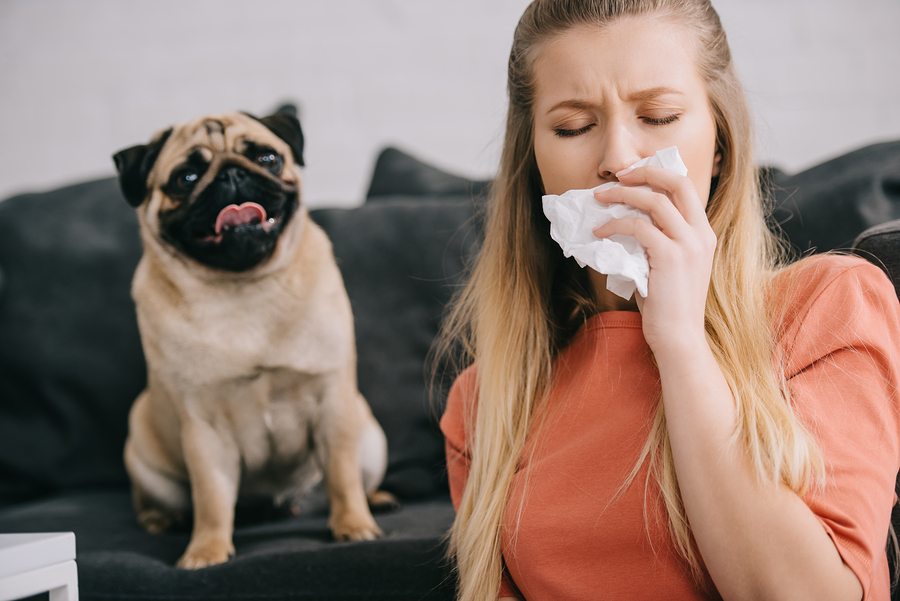
Is my cat or dog making me sick? Can I get an allergy-free dog or cat? Can pet allergies affect me even if I don’t own a dog or cat, or if I am not frequently around animals? Do I have to get rid of my pet if I do have animal allergies? These are common questions that I hear on a daily basis. Let’s explore pet allergy and answer these and many other common questions.
Cat and dog allergies are extremely common. Allergy symptoms triggered by animals can include runny nose, nasal congestion, sneezing, itchy watery eyes, wheezing, chest tightness, coughing, itchy rashes and headaches. If these symptoms worsen with exposure to pets, they can indicate a possible animal allergy. Sometimes, pet allergens can contribute to constant or seasonal symptoms when combined with other allergens. However, these symptoms may be triggered by other allergens picked up by an animal in the environment, such as mold, pollen, and dust, rather than the animal itself. Therefore, it is important to confirm dog and cat allergy through testing.
Allergy testing is a simple process where small amounts of allergens, including dog, cat, and other common allergens, are pricked on the skin using sterile plastic probes. If one is allergic, there will be a small red itchy bump or wheal where the skin was pricked. The results are available in 15 to 20 minutes.
If you have undergone testing and find that you are allergic to dogs or cats, the best treatment is removing the animal from your household. However, we understand that this may not always be desirable or possible. There are many options to reduce the exposure to animal allergens without getting rid of a beloved pet. These include:
- Keeping dogs and cats out of your bedroom, even when you are not at home.
- Running a portable, high-efficiency particulate air (HEPA) filter in your bedroom throughout the day and night to reduce allergen levels.
- Don’t pet, hug or kiss your animal. If you do, wash your hands afterward and make sure to avoid rubbing your face or eyes.
- Vacuum regularly using a high-efficiency or central vacuum cleaner.
- Give your pet a bath once a week, or as close to once a week as the animal will tolerate; though bathing an uncooperative cat is not recommended. Regular baths will reduce airborne allergen levels, but the effect is not sustained.
- Keep your dog or cat off of furniture.
- Clean carpets regularly, or preferably switch to wood, tile or linoleum flooring wherever possible.
- Placing dust mite encasings around pillows and mattresses, which may offer some benefit if you deal with a dust mite allergy in addition to an animal allergy.
- Medications including antihistamines (Claritin, Zyrtec, Allegra, Xyzal) and nasal corticosteroids (Flonase, Nasacort) will alleviate some symptoms, though these are not a long-term solution.
- Immunotherapy, or allergy shots, directed against dog and cat allergens, can desensitize patients against those allergens.< /li>
Many people ask about obtaining a hypoallergenic dog or cat. Certain breeds of dogs including poodles and several breeds of terriers are suggested as producing fewer allergens. Unfortunately, there are no breeds of cats or dogs that are completely hypoallergenic because animal allergens are found in their hair, skin, and saliva. Therefore, all cats and dogs produce allergens to some extent. Contrary to popular belief, the length or presence of an animal’s hair or their amount of shedding have no effect on the allergens they produce.
Even people who don’t have a dog or cat can have significant exposure to animal allergens at schools, restaurants, and workplaces due to allergens carried into that environment on the clothing of pet owners. If you do suffer from animal allergy, make sure you are prepared to experience and treat symptoms even if you do not personally own pets.
It is important to have a thorough evaluation by an allergist if you suspect a dog or cat allergy. Your pet may not be the cause of your allergic symptoms, and precautions can be taken even if you do have an animal allergy and own pets. Removing your pet is not always necessary, and there are many available treatment options. It is also wise to consider an allergy evaluation by an allergist if anticipating getting a new dog or cat, specifically if you have never owned a pet before.










